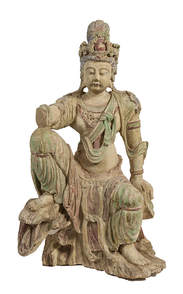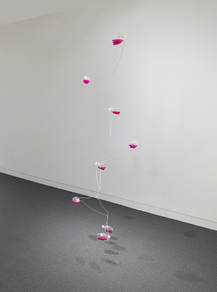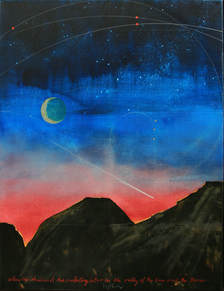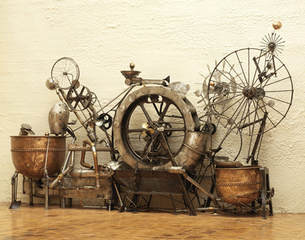Engineering: Systems: how things work
|
China, Ming dynasty
Guan Yin 16th-17th century Wood, paint, gesso UMFA1951.093 Gravity is one of nature’s most prevalent systems that we often take for granted. Try recreating this pose using your own body. How does your body move to counteract gravity so you don’t fall down? Guan Yin is a Buddhist Bodhisattva. She has achieved peace in her own life and chooses not to move on to the afterlife so she can help other people find happiness here on Earth. How does this pose make you feel?
|
Tony Feher (American, 1956-2016)
Pinks 2007 Plastic bottles, water, pink ink, twine, wire coat hangers UMFA2015.6.1 Tony Feher’s sculptures are made from everyday objects that he chose based on their visual properties rather than the function they were intended to serve. Pinks is an elaborate sculpture made from clothes hangers and small plastic water bottles filled with pink water that seems to defy gravity. What would this sculpture look like without the bottles? How does the placement of the bottles and the amount of liquid in them influence the shape of the sculpture?
|
Wulf Erich Barsch
Utah Within the Shadows of the Everlasting Hills: In the Valley of the Sun & Moon 2000 oil on canvas SMA2013.003 Barsch’s study of ancient Egyptian and Islamic art is evident in this piece through the use of exact proportions and “the Golden Mean.” He designed his work to inspire internal reflection for the viewer. His use of modern painting techniques with great color contrast and direct strokes contrasts with the more classic style of geometrical and mystical illusions. How did the artist use engineering to create this work?
|
Andrew Smith
Utah Moon Pool 2004 welded metal SMA2004.057 Smith creates his works of art from materials he collects in a variety of places, from antique shops to junkyards. Moon Pool incorporates many found objects, including the two large wheels that are the focus of the work. The pieces move through the use of a water pump that constantly circulates the water. The combination of running water and moving metal parts creates an experience for the viewer beyond merely looking at a work of art. Besides being fun to look at, how could this object be useful?
>> Click here to see this sculpture in motion << |
- Engineers figure out how things work and find practical uses for scientific discoveries. Look at each of these artworks and describe how you think the objects in them work.
- What makes an object useful? Take a walk around your classroom or school and notice things that you use everyday (doors, desks, pencils, bus, etc.) As a class make a list of the things that you see then discuss how they work and how they are useful. What would your day be like without them?
- Choose two of the artworks and make a comparison chart of similar and different characteristics. Choose three or more characteristics from your chart and design a new object. How does your object work? How is it useful?



